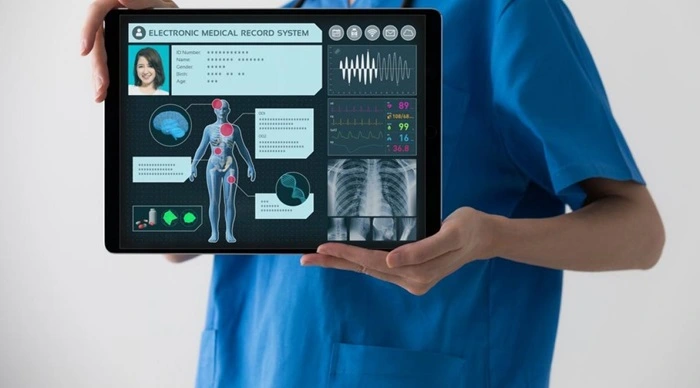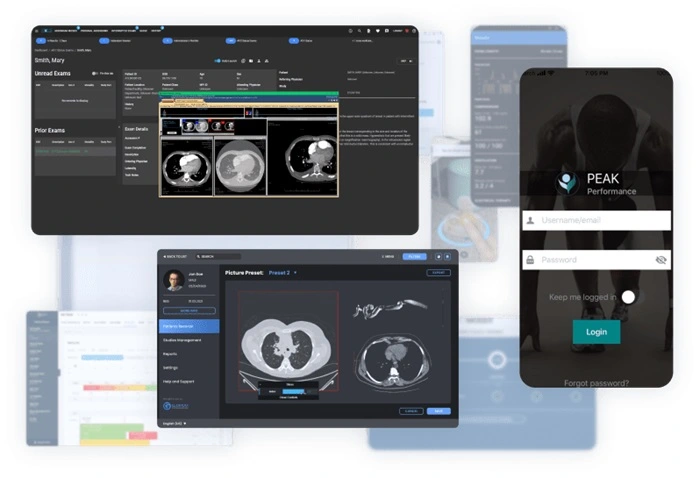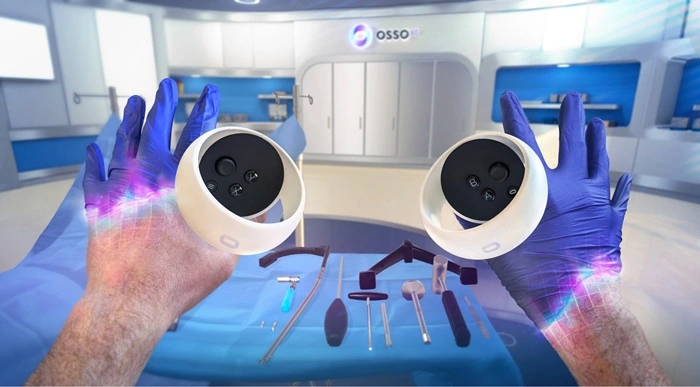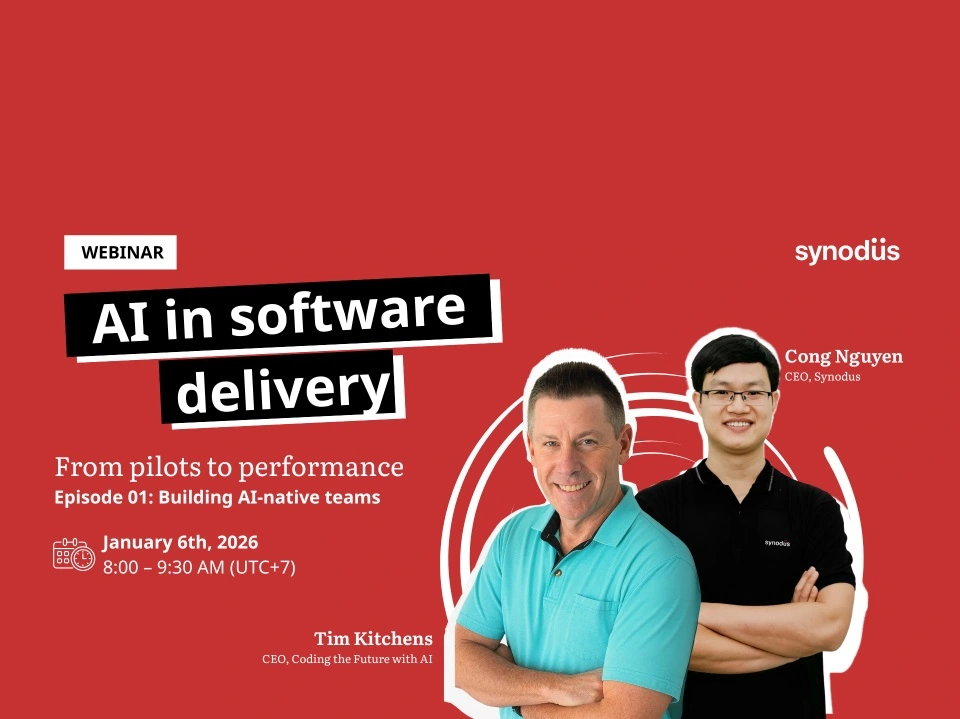5 core types of healthcare and medical software in 2026
These 5 different types of software used in healthcare we list below are the basic apps that hospitals and clinics should have for quality patient examination and care. These apps use technologies such as IoT, cloud-based or on-premises.
1. Electronic health/medical record software (EHR/EMR)
EHR and EMR are the key software used across hospitals and medical facilities of all sizes. They store patient data, treatment history, medication history, doctor’s diagnosis, prescriptions, medical images, lab results, and allergy records.
Previously, data were often stored in physical forms such as paper or spreadsheets, causing loss, damage, and asynchronous storage. Therefore, EHR and EMR came as a game-changer for medical recordkeeping by offering a uniform and digital storage. Data is updated in real-life, and staff can retrieve data at any point, from anywhere.

Some are even much more advanced with a portal where patients can access their health records, view test results, and contact their healthcare providers.
- User: Doctor, Hospital staff, Patient
- Common applications: Epic, Cerner, EHR your way
- Average development cost: $50,000 and $150,000
EHR vs EMR?
EHR is a larger system which can connect with data points outside a facility. Because of that, the government usually adopts EHR to build a centralized health system for citizens. Franchise hospitals use it to connect with their branches and smaller clinics.
Meanwhile, EMR is more compacted, focusing only on the use of data inside a facility. Hence, it’s best for small to mid-size hospitals and clinics.
2. Hospital information software (HIS/HMS)
HIS is a comprehensive suite that integrates a whole bunch of subsystems to lessen the burden of paperwork and manage hospital administration effectively. Thus, it helps hospitals increase productivity and efficiency while improving the patient experience throughout the medical examination and treatment process.
At the same time, HIS can be integrated with EHR or other core healthcare software mentioned below, creating a centralized internal management and optimization hub. It aims to fuel a paperless facility and streamline healthcare services.
Some key features include Patient registration, Emergency care management, Ward and bed management, Healthcare staff management, and Financial management
- User: Doctor, Hospital staff
- Common applications: Availity, HospitalRun
- Average development cost: $70,000 to $300,000
3. Appointment scheduling software
Making an appointment can be troublesome and time-consuming for both patients and doctors. This type of healthcare software will simplify this process.

Appointment management allows doctors to check their work schedules and saves hospital admins significant time and effort in registration. It provides patients with appointment-making, rescheduling, appointment canceling, and reminder options. It avoids common errors such as duplicate appointments and no-shows and reduces queue waiting times.
- User: Patient, Doctor, Hospital administrator
- Common applications: Simplybook.me, DoctorConnect, Tebra
- Average development cost: $10,000 to $40,000
4. Healthcare billing software
Healthcare billing software automatically generates bills for charged activities. It helps automate the payment process, reduce financial errors, and help patients easily manage their financial activities.
Some advanced ones also support insurance management, ensuring all claims are accurate and reducing denied rates.
Notable features include Claim processing, Electronic superbill, Eligibility verification, Payment reminders, Electronic remittance, and Insurance management.
- User: Financial department
- Common applications: WinPharm, GoFrugal
- Average development cost: $20,000 to $50,000
5. Pharmacy management software
Pharmacy management systems provide optimal solutions for controlling and monitoring inventory, ensuring you have adequate medicines.
The system will classify available, in-sale, usable medicine, and nonsalable items such as out-of-date products or recalled pharmaceutical ingredients.
It monitors inventory to avoid drug shortages. This software also supports drug price management, ensuring that drugs are coordinated with the right type and dosage. The software allows pharmacy staff to access the prescription information system in the pharmacy or through the health system’s channels.
- User: Doctors, Nurses, Pharmacy department
- Common applications: EClinicalWorks; CureMD
- Average development cost: $40,000 to $500,000
Additional healthcare software for SME to large facility
Unlike small clinics, large hospitals or health facilities often have many departments with hundreds to thousands of staff. Some even have branches and sub-clinics across a region. Because of that, using the 5 core types of healthcare software won’t be enough for their high demand. These additional apps will help connect the entire system better and provide more effective management.
1. Radiology information system (RIS)
RIS is a solution for storing and managing radiology images and scanning results. Like the Hospital Information System (HIS), RIS automates and streamlines management but is specifically designed for radiology departments.
This type of healthcare software often works in parallel with PACS (Picture archiving and communication system). The two systems complement each other and are integrated in most radiology departments, as well as integrated with EHR/EMR.
- User: Radiology departments, Doctors.
- Average development cost: $40,000 to $150,000
2. Laboratory information system (LIS)
Same as RIS, LIS is dedicated to laboratory departments. This type of healthcare software manages, updates, and stores test results, lab research, and many more. It receives test requests and sends them to laboratory analyzers, tracks result, performs quality control and transmits results to EHR analyzers or other information systems.
- User: Doctors, Lab staff.
- Average development cost: $60,000 to $300,000
3. Clinical trial management software
As its name implies, this type of healthcare software focuses on managing clinical trials, in which drugs and treatments are tested and analyzed on humans. It tracks all information related to the trial, including participant information, study documents, regulatory approvals, and adherence to protocols.
Clinical trial management software is usually used in first-level hospitals, which are leaders in a specific domain in a country. These facilities conduct extensive research and tests throughout the year and, hence, need a management system.
- User: Researcher, Lab
- Average development cost: $100,000
4. Telehealth and telemedicine
Post-pandemic, the demand for telehealth and telemedicine has grown unexpectedly, estimated at $285.7 billion by 2027.

Telehealth allows patients to be connected to reputable doctors and hospitals for overall diagnosis, participate in online consultations, monitor treatment results online, and conduct quick tests. This helps patients save time and money despite going directly to healthcare facilities.
5. mHealth for patients
Short for mobile health, mHealth is the application that hospitals build for their patients. These applications help patients complete various administrative tasks such as medical billing, appointment scheduling, and other patient-facing processes. It can also be integrated with EMR/EHR or HIS to support their function better.
- User: Patient, Doctor
- Average development cost: $50,000 to $300,000
6. e-Prescribing software
The e-prescription optimizes the prescribing process, allowing doctors to send prescriptions directly to pharmacies, eliminating the need for handwriting, phone calls, and faxes.
Aside from convenience, software can help avoid common errors in manual prescribing, which cause millions of dollars of compensation every year. E-prescriptions provide neat storage and effective management, ensure correct prescriptions, and allow patients to view their medication lists.
- User: Patients and Hospital
- Average development cost: From $20,000
7. Health equipment management system
This type of healthcare software tracks quantity, inventory status, maintenance, and replacement of each health equipment. It also keeps staff updated on equipment frequency of use and maintenance schedule. This software is often integrated as a module of a larger hospital management system.
- User: Hospital
- Average development cost: From $50,000
8. ERP system for healthcare
Unlike the other types of software on this list, healthcare ERP doesn’t focus much on patient-facing procedures or managing patient data. Instead, ERP is used for operational management and optimization. It offers support for financial management, supply chain management, human resources management, and strategic planning, such as expansion and merging.
- User: Hospitals, Management-related roles across departments.
- Average development cost: $100,000 to $500,000
9. CRM software for healthcare
Much like ERP, CRM manages historical data of past patients and customers so the sales team can interact with them later for post-treatment checking or insurance matters.
Voluntary healthcare services such as cosmetic surgery, orthodontics, aesthetics, and optometry rely heavily on customer relationship management (CRM). CRM optimizes this aspect, helping you improve your services and engage with customers, pulling them back to your clinics again and again.
- Average development cost: $40,000 to $250,000
10. Personal health application
This is probably the most popular type of healthcare application for ordinary users. It includes fitness tracker (step tracker …), heart rate tracker, diet and weight loss tracker, sleep tracker, etc., and even mental health and happiness tracker.
These applications are available on phones and come with wearable devices such as Apple Watch and Fitbit.
These applications not only provide users with an overview of their health status but also motivate them to be more active and pay more attention to their health.
- User: All demographic
- Average development cost: From $50,000 depending on the app.
Trending healthcare software for 2026 and the future
Technology can make the healthcare industry more accurate, engaging, and convenient. In addition to the standard types of healthcare software I mentioned above, many large facilities are investing in emerging technologies to remain the leaders in the field.
These are future software used in the healthcare industry.
1. Medical imaging software

Medical imaging technology has made great strides over the years, especially X-ray, PET, MRI, and CT technologies, which have made important contributions to the early detection of trauma and cancer.
Medical 3D will soon join the race. 3D technology simulates body organs visually and accurately. In cases of plastic surgery, such as jaw or oral surgery, doctors can predict the surgery results.
3D printing technology can also recreate artificial body parts, such as prosthetic limbs or the patient’s dental mold in the case of braces.
2. AI medical diagnosis software
Medical diagnostic software can be grouped into two main categories: Application for patients and Application for medical professionals.
Patient applications are often simple survey questionnaires and chatbots that answer questions about health conditions based on the data provided, instead of having patients search through millions of results on Google.
Some types of healthcare software also utilize AI for medical professionals to help doctors collect and analyze data, contributing to faster diagnosis and research points.
3. Remote patient monitoring software (RPM)
RPM tools collect patient health data and transmit it to healthcare professionals, who can then review it and make necessary decisions based on it.
This technology plays a huge role for patients who need 24/7 care, such as those with cardiovascular problems, asthma, mental illness, diabetes or hypertension.
Currently, these applications are integrated in wearable devices such as smart watches, ECG monitors, blood pressure and heart rate monitors. In the future, it will be more common to implant tracking chips directly into the body.
4. Remote medical training
Medical students or medical interns also benefit greatly from IT technologies in the healthcare industry. Integrating tools such as virtual reality or augmented reality can help students interact more directly and intuitively with learning materials.
For instance, Osso VR is a popular application in surgical training.

5. Use of blockchain in healthcare
Information security is also a big issue in medical practice, especially when dealing with a huge amount of sensitive patient information. With the blockchain feature that cannot be changed or counterfeited, blockchain technology is introduced to enhance the security of this sensitive data.
For example, you can use blockchain to verify insurance data. It creates a single source of data for the reference of involved parties, such as hospitals and insurance companies, which helps prevent insurance fraud.
Choosing a suitable healthcare software
How to know which types of healthcare software is best for your needs and facility’s size? Even if you have selected your type, you then face dozens to hundreds of choices on market, how to know which is “the one”?
1. Things to consider
Other than considering their price and features, here are the things that most people neglect when choosing a healthcare software:
Regulation: Before putting down your money, check if the software matches the regional healthcare standards and data privacy protection requirement. For example, HL7 standard is used globally, while HIPAA is for the US and GDPR is for the EU.
Localization: Healthcare software doesn’t only serve doctors and healthcare staff, but also serves the local. It must support your nation’s language, be friendly to users of all demographics, and comply with local culture values. For examples, Muslim country should opt for app that support Islamic morality.
Security: Every piece of patient data is sensitive. Take a deep look into the system, making sure it can gatekeep your most valuable asset away from any threats.
Flexibility in dealing with your internal process: Each healthcare facility has their own way in caring patients and handling paperwork. You would love a system that can be flexibly adjusted to your workflow, not the other way around.
Training and support for vendors: Switching to a new system or going from paper-based to paperless asks doctor and staff to spend time getting used to. It would be a plus if your vendor provided thorough training and 24/7 support to keep a 100% adoption rate.
2. When to customize?
Customization is a strategy that many facilities opted for. But it’s time-consuming and requires lots of funds, when to go for it?
- If you have a large facility, or a healthcare franchise with hospitals and clinics across a location.
- When your facility processes a huge amount of data daily.
- When your facility has many cross-departments workflow and you need a centralized system.
- When commercial systems can’t precisely match your requirements, internal workflow, or localization challenges.
One way to optimize development time is Packaged solution, which is pre-built with all fundamentals, then will be customized after to match your facility to every detail.
Synodus is the leader in this type of healthcare software. We have provided Packaged solution and Custom from scratch for 30+ healthcare facilities in APAC and 10,000+ healthcare staff.
If you are looking for:
- A scalable HIS that can boost 300% of your revenue
- A smart EMR/EHR for small to large facility to get rid of paperwork.
- A patient-facing mobile app or for commercial use.
- An internal tool for your facility: Clinical trials, ePrescribing, CRM, ERP, inventory, etc.
- Integration of Data Analytics into your facility.
Then we are the right choice.
Need experienced & cost-effective healthtech developers?
Related Reading: Healthcare Tech Insights
- Top 10 hospital information system vendors in 2026: Custom vs OTS
A comparison of leading HIS vendors and tips to choose the right one for your healthcare facility - 20+ medical and healthcare software development companies of 2026
Key criteria and red flags when selecting a custom healthcare software partner - Top EHR/ EMR software development companies: 2026 ranking
Explore trusted development companies building secure, compliant EHR/EMR systems - Top 10 telemedicine app development companies in Europe, US & Asia
Dive into the rise of telehealth apps and how to build one for your care model - Reviewing top 17 SaMD companies in the US, EU, Asia & Oceania
A curated list of SaMD solution providers ensuring clinical-grade digital innovation. - 10 EMR & EHR consulting companies for smooth implementation
Find consulting firms that streamline EMR/EHR implementation and strategy. - Top 15 fitness app development companies: From MVP to Live product
From step trackers to AI coaches — here’s who’s leading the way in fitness tech.
FAQ on healthcare software
Healthcare software automates your facilities’ workflow, enhances data management, supports patients during their journey, improves quality of care and streamlines the billing process.
Everyone, from doctors, nurses, healthcare staff to patients. Depending on the type of healthcare software, there’re apps that are made specifically for one, but also others that both patient and doctor can use.
Most used software includes electronic health/ medical record software (EHR/EMR); hospital information software (HIS/ HMS); appointment scheduling software; healthcare billing software, and pharmacy management software.
Most used technologies in healthcare industry are: IoT, Cloud computing, Data analytics, Automation, BPA, Remote monitoring, Wearables, Mobile app, Web portal, Blockchain, AI, AR/VR, Telehealth, Chatbot, 3D printing.
Wrapping up
From our list of all the types of healthcare software, we hope that you can find the right match for your facility. Remember to consider your own usage and avoid spending too much on something that you don’t need.
How useful was this post?
Click on a star to rate it!
Average rating / 5. Vote count:
No votes so far! Be the first to rate this post.




